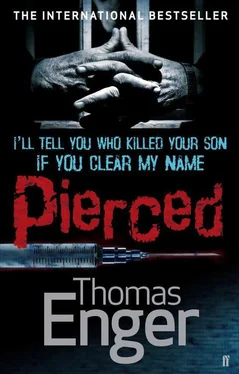Rasmus Bjelland and his Brazilian wife were not among those arrested though their office was turned upside down. This led to suspicions that Bjelland had been in cahoots with the police prior to the raids and that the search of his office was purely for show. It didn’t take long before a price was put on his head and Bjelland went into hiding.
Rumours that a minor Norwegian property tycoon in Brazil now headed the hit list of several organised crime gangs soon reached most news desks, and Henning knew that Bjelland would not be easy to find. One day, however, he received a tip-off that Bjelland had settled with his creditors in Norway and had applied for witness protection — a request granted to only a few people since Kripos set up the programme in 2004.
After several phone calls back and forth, Henning finally tracked down a middleman who agreed to pass on a request for an interview, but it was turned down point blank. Nor did Bjelland take Henning’s bait that the article could serve as a pre-emptive defence brief. Henning had practically given up when the middleman contacted him and told him that Bjelland had changed his mind.
One overcast day in the summer of 2007 they met at Huk Beach. Henning remembers a man who was scared of the shadows and ready to do whatever it took to appear innocent and unjustly accused. In theory, talking to Norway’s most wanted man was a scoop, but Henning was left with a bad taste in his mouth — not necessarily because he believed that Bjelland was lying, but because he was allowing himself to be used as Bjelland’s mouthpiece. Another of Bjelland’s demands was that Henning would not write anything about his application for a new identity, which was being processed, since it would make him look even more suspicious; nor would he tell the readers that Bjelland was planning on staying in Norway. Henning had had to bite on this bullet, too. He even remembered the headline: I’m No Snitch.
Perhaps that’s the answer, Henning thinks to himself. Maybe the people who were looking for Bjelland thought that Henning knew Bjelland’s location since he had managed to interview him. But why torch Henning’s flat?
Perhaps they had made previous attempts at contacting Henning before opting for a more drastic approach. For all Henning knows, they may not have meant for anyone to die, only for Henning to become more co-operative. No matter what their motive was, it wouldn’t have worked. Henning never knew the identity of the middleman. Their only point of contact had been through an anonymous email address.
Henning looks up his own story on the Internet. With the benefit of hindsight he sees that it was definitely a good one. He took a fine picture of Bjelland from the back with a hood covering his head, looking out across Oslo Fjord. Mysterious and appealing. The story offered hitherto unpublished information. Reading his old article again stirs a memory in Henning of the man he was before Jonas died. He can hear the hunger in his own voice in the hunt for the big story. He recognises the feeling, not because he plans to write anything about Jonas but because he senses he might have hit on something.
He checks the Internet for more recent information about Bjelland, but his searches generate no hits. That must mean his application for a new identity was approved, Henning thinks. In other words, Rasmus Bjelland could be anywhere in Norway with a new face. Finding him again would be practically impossible. Nor is there much to suggest it would serve any purpose.
B-gjengen or Svenskeligaen, Henning thinks. He knows there aren’t many members of Svenskeligaen left in Oslo. And he can’t knock on the door of B-gjengen and ask them if they were behind a fire in a flat that led to the death of a six-year-old boy. He has to come up with another way to approach them.
But how?
The answer is obvious though it goes against the grain and holds little appeal for Henning.
Tore Pulli.
Before Thorleif unlocks his car, he stops and glances around. Cars and buses zoom up and down Bygdoy Alle. Pedestrians are quietly using the pedestrian crossing, but nobody is walking down Nobelsgate in his direction. His hands tremble as he opens the door and gets in. He checks the rear-view mirror. Sees nobody.
He takes a breath, starts the engine and drives towards the centre of Oslo where he finds a parking space in Kirkegaten. The engine has just stopped when there is a bang on the windscreen. Thorleif is startled and jumps, but all he sees is a man in tracksuit bottoms and a white T-shirt walk away from the car at a leisurely pace.
Then Thorleif notices the yellow Post-it note attached to the windscreen. He gets out, searches for the man and sees him disappear around the corner. He doesn’t look back. Thorleif snatches the note and reads what it says.
Oslo Cathedral. Five minutes.
A wave of panic sweeps through him, and he has to make an effort to breathe. It’s starting again. He leans forwards and supports himself against the bonnet of the car while he tries to calm down. He stands like this for a while before he straightens up and takes a deep breath. Then he walks up Kirkegaten in the direction of the cathedral whose spire and verdigris top soar towards the open sky. His footsteps are feeble, reluctant, as if deep down he is hoping they will refuse to lead him to his executioner, acquire a will of their own and carry him to safety. Thorleif looks up at the pedestrians coming towards him, trying to make eye contact, but nobody returns the looks he gives them. I’m on my own, he thinks. I’m the only one who can deal with this.
He crosses Karl Johansgate and continues towards the cathedral while he wonders if he can stop himself from crying. The cathedral door is open, he sees, as he crosses the street by the taxi rank on Stortorvet. He enters the darkness and is instantly mesmerised by the silence that always fills a church space.
He hears mumbling, sees fingers pointing up at the ceiling, at the stained-glass windows and the paintings. He checks his watch. He needs to be at work in five minutes. He swears quietly to himself and instantly feels remorseful in view of the location and his surroundings. His shame evaporates when he detects the smell of leather behind him. He spins around and stares right into a grave face. The same face he learned to fear yesterday.
They remain opposite each other for a while. The man looks at Thorleif for a long time before he nods and walks further into the cathedral. Thorleif follows him. They sit down on a bench. The man waits until a group of Japanese tourists have moved on. Then he slips one hand into the inside pocket of his leather jacket and takes out a box. He opens it with care and shows it to Thorleif.
‘W-what’s that?’ Thorleif whispers, looking down at it. Reluctantly, he realises that he is intrigued.
‘This,’ the man says, reverently. ‘This is a piercing needle.’
‘Are you all right?’
Thorleif looks up at Guri Palme’s concerned face.
‘You’re as white as a sheet. Are you sure you’re okay to work?’
‘Oh, yes,’ Thorleif groans, and forces a smile. ‘I’ll be fine. But I think I might not start the editing today.’
‘Fine. It’s not going out until Saturday, anyway,’ Palme says sympathetically. ‘Are you really all right? You look terrible.’
‘I’ll be fine,’ he assures her.
Palme scrutinises him for several seconds before she puts her hand on his shoulder.
‘Good. It’s a big day today.’
They get into a white Peugeot 207 with TV2’s familiar ‘2’ and the letters ENG 12 on the right front wing and drive off. He is numb; it’s as if the body sitting in the car doesn’t belong to him. He can’t feel the seat underneath him.
Читать дальше












